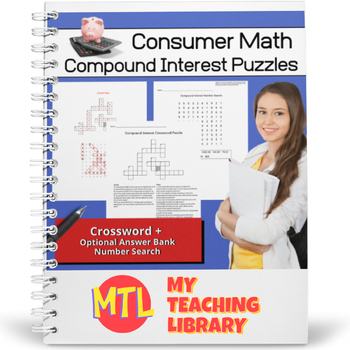Consumer Math | Compound Interest Puzzles
My Teaching Library
134 Followers
Grade Levels
7th - 12th, Adult Education, Homeschool
Subjects
Resource Type
Standards
CCSSHSA-SSE.A.1
CCSSHSA-SSE.A.1a
CCSSHSA-SSE.A.1b
Formats Included
- PDF
- Easel Activity
Pages
3 pages
My Teaching Library
134 Followers
Easel Activity Included
This resource includes a ready-to-use interactive activity students can complete on any device. Easel by TPT is free to use! Learn more.
Also included in
- Engaging crossword puzzles to give students the practice they need to master solving word problems dealing with simple and compound interest. Each resource in the bundle can be differentiated by using the optional number search puzzles (answer banks).Price $3.00Original Price $3.50Save $0.50
- This bundle will teach students about both simple and compound interest and give them the practice they need to help them master solving word problems! Includes: Instructional pages60 word problems in the main teaching resource: 3 sets of 10 simple interest problems and 3 sets of 10 compound interesPrice $6.00Original Price $7.50Save $1.50
Description
Financial Literacy: Students will complete a crossword puzzle by answering compound interest word problems.
Great a differentiated lesson by using the included (optional) number search puzzle which will provide an answer bank to use when completing the crossword puzzle!
Answer Keys provided.
Sample problem: How much interest does a $472 investment earn at 7% compounded annually over eight years?
Total Pages
3 pages
Answer Key
Included
Teaching Duration
N/A
Last updated Oct 3rd, 2020
Report this resource to TPT
Reported resources will be reviewed by our team. Report this resource to let us know if this resource violates TPT’s content guidelines.
Standards
to see state-specific standards (only available in the US).
CCSSHSA-SSE.A.1
Interpret expressions that represent a quantity in terms of its context.
CCSSHSA-SSE.A.1a
Interpret parts of an expression, such as terms, factors, and coefficients.
CCSSHSA-SSE.A.1b
Interpret complicated expressions by viewing one or more of their parts as a single entity. For example, interpret 𝘗(1 + 𝘳)ⁿ as the product of 𝘗 and a factor not depending on 𝘗.







